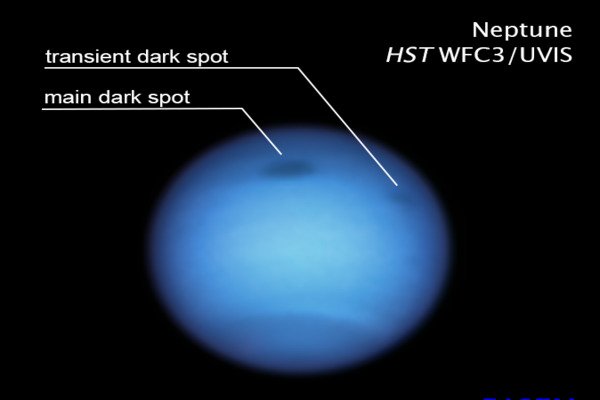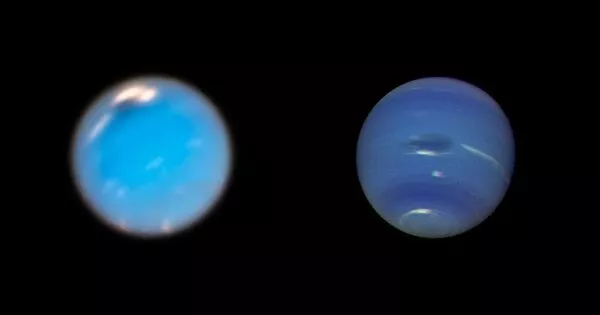Astronomers using NASA’s Hubble Space Telescope observed a mysterious dark vortex on Neptune abruptly steer away from the giant blue planet’s likely death. The storm, which is larger than the Atlantic Ocean, formed in the planet’s northern hemisphere and was discovered in 2018 by Hubble. A year later, observations revealed that it had begun to drift southward toward the equator, where such storms are expected to vanish. Surprisingly, Hubble observed the vortex changing direction by August 2020, doubling back to the north. Despite the fact that Hubble has tracked similar dark spots for the past 30 years, this unpredictable atmospheric behavior is novel.
The storm was not alone, which was equally perplexing. Hubble discovered another smaller dark spot near its larger cousin in January of this year. It could have been a piece of the massive vortex that broke off, drifted away, and then vanished in subsequent observations.
“We’re excited about these findings because this smaller dark fragment could be part of the dark spot’s disruption process,” said Michael H. Wong of the University of California, Berkeley. “This is a previously unknown process. We’ve seen some other dark spots fade away and disappear, but we’ve never seen anything disrupt, despite computer simulations predicting it.”
The 4,600-mile-wide storm is the fourth dark spot Hubble has discovered on Neptune since 1993. Two other dark storms were discovered by the Voyager 2 spacecraft as it flew by Jupiter in 1989, but they vanished before Hubble could observe them. Since then, only Hubble has had the sharpness and sensitivity in visible light to track these elusive features, which have appeared and then faded away in two-year cycles. Hubble discovered the most recent storm in September 2018.
We’re excited about these findings because this smaller dark fragment could be part of the dark spot’s disruption process. This is a previously unknown process. We’ve seen some other dark spots fade away and disappear, but we’ve never seen anything disrupt, despite computer simulations predicting it.
Michael H. Wong
Wicked Weather
The dark vortices of Neptune are high-pressure systems that can form in the mid-latitudes and then migrate to the equator. They start out stable due to Coriolis forces, which cause storms in the northern hemisphere to rotate clockwise due to the planet’s rotation. (These storms, unlike hurricanes on Earth, rotate counterclockwise due to their low pressure.)
As a storm approaches the equator, the Coriolis effect weakens and the storm disintegrates. Several different teams’ computer simulations show that these storms follow a more-or-less straight path to the equator until there is no Coriolis effect to keep them together. Unlike in the simulations, the latest massive storm did not move into the equatorial “kill zone.”
“It was really exciting to see this one act like it’s supposed to act and then all of a sudden it just stops and swings back,” Wong said. “That was surprising.”

Dark Spot Jr.
The Hubble observations also revealed that the dark vortex’s puzzling path reversal occurred at the same time that a new spot, informally deemed “dark spot jr.,” appeared. The newest spot was slightly smaller than its cousin, measuring about 3,900 miles across. It was near the side of the main dark spot that faces the equator – the location where some simulations show a disruption would occur.
However, the appearance of the smaller spot came at an unusual time. “When I first noticed the small spot, I assumed the larger one was being disrupted,” Wong explained. “I didn’t expect another vortex to form because the small one is closer to the equator.” So it’s in this volatile area. However, we cannot prove that the two are related. It is still a complete mystery.” “The dark vortex also stopped moving and began moving northward again in January,” Wong added. “Perhaps shedding that fragment was enough to prevent it from moving towards the equator.”
The researchers are continuing to analyze more data to determine whether remnants of dark spot jr. persisted through the rest of 2020.
Dark Storms Still Puzzling
It’s still unclear how these storms form, but this latest massive dark vortex has received the most attention. The storm’s dark appearance could be due to an elevated dark cloud layer, which could reveal information about the storm’s vertical structure to astronomers.
Another peculiar feature of the dark spot is the lack of bright companion clouds surrounding it, which were visible in Hubble images taken when the vortex was discovered in 2018. When the vortex came to a halt to the south, the clouds vanished. When the flow of air is disrupted and diverted upward over the vortex, gases likely freeze into methane ice crystals, forming the bright clouds. According to researchers, the lack of clouds could reveal information about how spots evolve.
Weather Eye on the Outer Planets
Many of the dark spots were photographed by Hubble as part of the Outer Planet Atmospheres Legacy (OPAL) program, a long-term Hubble project led by Amy Simon of NASA’s Goddard Space Flight Center in Greenbelt, Maryland, that captures global maps of our solar system’s outer planets when they are closest to Earth in their orbits.
The primary goals of OPAL are to study long-term seasonal changes as well as to capture comparatively transient events, such as the appearance of dark spots on Neptune or possibly Uranus. These dark storms may be so fleeting that they appeared and faded during multi-year gaps in Hubble’s observations of Neptune in the past. Astronomers will not miss another one thanks to the OPAL program.
“Without Hubble, we wouldn’t know anything about these latest dark spots,” Simon said. “We can now track the large storm for years and observe its entire life cycle. Without Hubble, we might believe that the Great Dark Spot seen by Voyager in 1989 is still present on Neptune, similar to Jupiter’s Great Red Spot. We also wouldn’t have known about the four other locations discovered by Hubble.” Wong will present the team’s findings on December 15 at the American Geophysical Union’s fall meeting.





